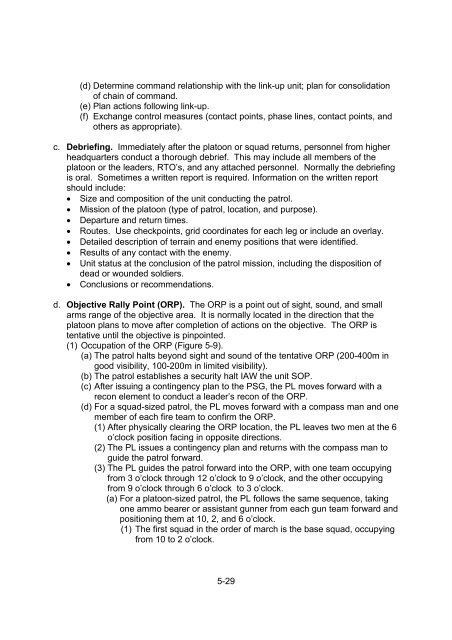You also want an ePaper? Increase the reach of your titles
YUMPU automatically turns print PDFs into web optimized ePapers that Google loves.
(d) Determine command relationship with the link-up unit; plan for consolidation<br />
of chain of command.<br />
(e) Plan actions following link-up.<br />
(f) Exchange control measures (contact points, phase lines, contact points, and<br />
others as appropriate).<br />
c. Debriefing. Immediately after the platoon or squad returns, personnel from higher<br />
headquarters conduct a thorough debrief. This may include all members of the<br />
platoon or the leaders, RTO’s, and any attached personnel. Normally the debriefing<br />
is oral. Sometimes a written report is required. Information on the written report<br />
should include:<br />
• Size and composition of the unit conducting the patrol.<br />
• Mission of the platoon (type of patrol, location, and purpose).<br />
• Departure and return times.<br />
• Routes. Use checkpoints, grid coordinates for each leg or include an overlay.<br />
• Detailed description of terrain and enemy positions that were identified.<br />
• Results of any contact with the enemy.<br />
• Unit status at the conclusion of the patrol mission, including the disposition of<br />
dead or wounded soldiers.<br />
• Conclusions or recommendations.<br />
d. Objective Rally Point (ORP). The ORP is a point out of sight, sound, and small<br />
arms range of the objective area. It is normally located in the direction that the<br />
platoon plans to move after completion of actions on the objective. The ORP is<br />
tentative until the objective is pinpointed.<br />
(1) Occupation of the ORP (Figure 5-9).<br />
(a) The patrol halts beyond sight and sound of the tentative ORP (200-400m in<br />
good visibility, 100-200m in limited visibility).<br />
(b) The patrol establishes a security halt IAW the unit SOP.<br />
(c) After issuing a contingency plan to the PSG, the PL moves forward with a<br />
recon element to conduct a leader’s recon of the ORP.<br />
(d) For a squad-sized patrol, the PL moves forward with a compass man and one<br />
member of each fire team to confirm the ORP.<br />
(1) After physically clearing the ORP location, the PL leaves two men at the 6<br />
o’clock position facing in opposite directions.<br />
(2) The PL issues a contingency plan and returns with the compass man to<br />
guide the patrol forward.<br />
(3) The PL guides the patrol forward into the ORP, with one team occupying<br />
from 3 o’clock through 12 o’clock to 9 o’clock, and the other occupying<br />
from 9 o’clock through 6 o’clock to 3 o’clock.<br />
(a) For a platoon-sized patrol, the PL follows the same sequence, taking<br />
one ammo bearer or assistant gunner from each gun team forward and<br />
positioning them at 10, 2, and 6 o’clock.<br />
(1) The first squad in the order of march is the base squad, occupying<br />
from 10 to 2 o’clock.<br />
5-29


